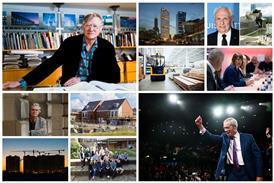From sustainability credentials to reuse potential, we ask Asselia Katenbayeva about the properties of steel and the challenges facing the industry

The economic output of the steel industry totals £2.4 billion, 0.1% of the UK economy and 1.2% of manufacturing output. However, the industry is facing a number of challenges – particularly in light of rising energy costs – and decarbonisation has become an important part of the sector’s targets.
Building Design sat down with Asselia Katenbayeva, research associate at The Alliance for Sustainable Building Products (ASBP), to find out more about the benefits of specifying steel and how the industry’s main challenges can be overcome.
What are the different types of steel and how do they differ?
Steel is an alloy composed of iron and carbon with other elements in varying amounts. Carbon steel is basic and composed of iron and carbon with a carbon content of 0.05%-2%, while stainless steel contains at least 10.5% chromium, making it resistant to corrosion and staining.
Alloy steel contains other elements besides carbon that can improve its properties, whilst tool steel is specifically designed for cutting, drilling, and shaping materials.
High-speed steel is a type of tool steel that can withstand high temperatures and pressures without losing its strength.
Can you describe the properties of steel? What are some of the benefits of specifying the material?
Steel is known for its strength, durability, corrosion resistance, ductility, and weldability.
Steel’s properties make it ideal for structures that require flexibility, a long lifespan, and the ability to withstand heavy loads or harsh environments.
More than half of all steel produced is used in construction. Most multi-storey buildings are based on steel structural frames.
Structural sections are inert, robust and dimensionally stable elements that form the structural frame of a steel building.
Is steel a sustainable material?
Steel is the world’s most widely used material but also one of the most carbon-intensive ones. The production of a tonne of steel generates on average 1.85 tonnes of CO2 emissions. The steel industry is responsible for between 7% and 9% of the world’s CO2 emissions.

What are the main challenges the steel industry is currently facing? And how can these be overcome?
The construction sector is the largest consumer of steel products. Many buildings are currently demolished before the end of their technical lifetime, in particular commercial buildings that are often only used for 30 to 40 years compared to a technical lifetime of 75 years or more (IEA, 2020).
While steel is widely recycled (circa 95% recycling rate in the UK), more benefits can be derived from reusing steel that avoids the high energy process of remelting.
Steel reuse provides up to 96% carbon savings compared to using virgin steel. Reusable steel is also cheaper than new steel, so it can provide cost savings to the project if well managed.
Importantly, reuse enables the specification of local material – scrap generated in the UK. Currently, 77% of scrap steel is exported and remelted in other countries as the UK lacks recycling plants.
Out of 11.3 million tonnes of scrap steel produced in 2018, only 2.6 million tonnes was used in domestic steelmaking (which is a mixture of a Blast Furnace – Basic Oxygen Furnace and Electric Arc Furnace production).
The remaining 8.7 million tonnes was exported for recycling in other countries including Turkey, Pakistan, Egypt and India.
A survey of demolition contractors showed that around 5% of steel products on average from demolished buildings were reused in 2012 in the UK.
Steel reuse is not a new practice; according to Roy Fishwick from Cleveland Steel and Tubes, it was more common 30-40 years ago but with the evolution of standards and the market’s interpretation of them the reuse of steel sections in the UK reduced significantly by 2012.
Driven by low carbon targets, steel reuse has gained momentum recently, with more actors in the supply chain calling for a collaborative approach to encourage steel reuse in construction projects.
Postscript
A new ‘toolkit’ has been developed as part of the ASBP-led ‘Delivering Innovative Steel ReUse Project‘ (DISRUPT) which aims to provide major supply chain stakeholders with guidance to facilitate new market entrants and achieve a greater supply of reused steel in the construction industry.















No comments yet